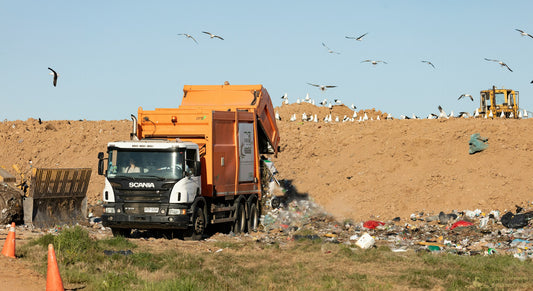
Chilly Composting: Eco-Friendly Ways to Dispose of Winter Debris
Share
As winter approaches, homeowners grow wary of debris gathering in front and backyards. While many ways make getting rid of winter debris easier, a lot of them lack sustainability.
There are a variety of options for property owners to take care of their yards during winter while staying eco-conscious.
Winter debris appears in the form of dry leaves and branches all over the exteriors of our homes. Rather than turning to more traditional disposal methods which could hurt the planet, try using chilled composition instead.
Such an eco-friendly approach makes it possible for you in terms of efficient management of winter debris for healthy gardens and the planet while simultaneously saving on utilities by saving energy and resources.
Understanding Chilly Composting:
Cold composting, also known as chilly composting is the process by which organic materials are decomposed at lower temperatures than that of hot composting.
Cold composting unlike hot composting has a perfect mix of greens and browns and one has to keep on turning it regularly. That’s a good option for those individuals who would like to perform composing in winter, when low temperatures are a challenge for the traditional compost.
Materials for Chilly Composting:
Winter Debris:
Gather leaves, twigs, or small branches from your home yard. Chilly compost is made from materials that overflow during winter.
Kitchen Scraps:
Use kitchen rubbish like fruit skin, vegetables, coffee grounds, and egg shells. You have to ensure that there is an appropriate mix of green and brown material for proper composting.
Cardboard and Paper:
Break up cardboard and newspaper into little bits, as they make great carbohydrates for your compost pile. This ensures a necessary balance for decomposition to take place. Just ensure you don't add glossy paper or cardboard, which could contain toxic ink.
Yard Waste:
You can add other types of yard waste such as grass clippings and used plants to your compost. This enhances a diverse array of materials that aid in the development of a quality microenvironment for composting.
Chilly Composting Benefits:
Year-Round Sustainability:
The application of chilly composting all year round is one of the crucial benefits that this process has over the other types of composting methods. Cold composting differs from hot composting which tends to diminish at lower temperatures therefore guaranteeing an all-year-round waste disposal channel and ensuring a sustainable method.
Low Maintenance:
Chilly composting has also been characterized as a low-care process, which may go without saying for those who have little time on their hands. Hot composting demands periodic stirring and observing, while cold composting just follows the natural process, periodically controlling the proportions of ingredients.
Nutrient-Rich Soil Amendment:
Chilly composting takes a lot of time but it leads to the development of excellent nutrients that are useful for your soils in improving their quality. For instance, this is a natural fertilizer that makes the garden soil structure more porous, increases water-retaining ability, and boosts nutrient levels for improved growth of plants.
Reduction of Landfill Waste:
Composting dry and wet leaves during winter and kitchen leftovers helps reduce the quantity of biodegradable matter which is eventually dumped in local landfills.
This trash is channeled into chilly composting, diverting it from the already overloaded landfills.
How to Start Chilly Composting:
Pick a compost bin or find a spot in the yard for composting. The bins with the lids greatly regulate moisture and temperature, especially during winter times. Start with layering the different materials in a compost pile. Commence with a layer of winter trash, then follow up with more easily compostable materials such as kitchen leftovers, cardboard or paper, and yard waste. Go on with this layering until the compost bin becomes complete.
Keep an equilibrium of greenery as compared to brownery. The green material helps in providing nitrogen and the brown material adds carbon. Aim for a ratio of roughly 3:1 brown to green materials.
However, turning is necessary in cold composting as it speeds up the decomposition process. Ensure that all the materials break down uniformly by turning the compost every few weeks.
Challenges and Tips:
Slow Decomposition:
Compared to hot composting, chilly composting is characterized by lower temperatures, which might make it slow. If you want to accelerate it, cut larger materials into chips, and do not forget about the proper balance between the green and the brown parts.
Winter Moisture Management:
Winter can bring additional challenges, such as excess moisture. Ensure your compost bin has proper drainage to prevent waterlogging. If necessary, cover the bin with a tarp during heavy rain or snowfall.
Adjusting Ratios:
Pay attention to the balance of green and brown materials. In winter, when green materials may be scarcer, adjust the ratio accordingly to maintain a healthy composting environment.
Conclusion
Winter debris is disposed of in a friendly way through chilly composting thus offering sustainability, low maintenance costs, and nutrient-rich compost. By embracing this method, you minimize the environmental impact, increase the value of your property, have a healthy garden for yourself, and support the world in general.
We hope you enjoyed this article. If you want to read more like this, make sure to check out our Blog and follow us on Instagram. If you are interested in truly sustainable products, check out our Shop.
If you want to engage in the discussion, feel free to leave a comment below.







